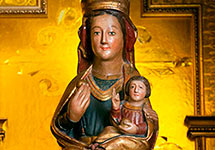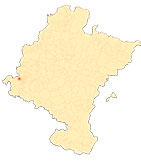Sanctuary of Nuestra Señora de Codés
By Pilar Andueza Unanua
The image of Our Lady of Codés
From agreement with the tradition, extended thanks to the work of Juan de Amiax (chapters 8 and 9 of the first book of the Ramillete), the origin of the image was located in the city of Cantabria, near Logroño. In the year 575 the Visigothic king Leovigild would have destroyed that enclave, resulting in reality a divine punishment for the disorderly and sinful life of its inhabitants who had also disregarded the preaching of San Millán de la Cogolla. However, some devotees would have taken the image and placed it, together with numerous relics, in the mountains of Torralba "for being such a rough and mountainous land" that allowed its safeguarding. Those Christians gave the statue the name of Our Lady of Cadés, recalling the Book of Ecclesiasticus (24:18: Quasi Palma exaltata sum in Cades). And so, at an undetermined date - always according to the narration of Amiax - a small Shrine of Our Lady of Fair Love would have appeared on Mount Yoar with the Marian image covered by large thorns.
This origin, like that of other Spanish advocations with which Amiax establishes a parallelism, is mythical in the light of the scientific research . In fact, it can in no way correspond to the image that today presides over the sanctuary of Codés, a seated carving of Gothic style that Fernández-Ladreda dates to the middle of the 14th century and relates it to the Basque-Navarrese-Riojan iconographic subject . Much restored over time, Mary wears a dark tunic, a wide golden mantle, and is touched by a crown. She holds a ball in her right hand, while with the other she holds the Child who, leaning on her left leg, she blesses with her right hand. Photographs are preserved, used as devotional prints, from the first half of the twentieth century where the image is dressed and wears a rostrillo, crown and halo.
The date of the image could coincide, on the contrary, with a "very old" papal bull dated June 8, 1358 in Avignon, which Amiax pointed out was kept in the sanctuary. In this document, "the devotion and construction of the Shrine of Our Lady of Fair Love of Our Lady of Codés" was entrusted.
AMIAX, J. de, Ramillete de Nuestra Señora de Codés, Pamplona, By Carlos Labayen, 1608.
History of Our Lady of Codés. Sencillos apuntes sobre Codés, Logroño, Cofradía Administradora del Santuario de Nuestra Señora de Codés, 1939.
ANDUEZA UNANUA, P, "El Santuario de Nuestra Señora de Codés: historia, arte y devoción", in FELONES MORRÁS, R. (coord.), En montes y valles. Santuarios en Tierra Estella, Estella, Cofradías de Nuestra Señora del Puy, Nuestra Señora de Codés y San Gregorio Ostiense, 2017, pp. 52-65.
AZANZA LÓPEZ, J. J., Arquitectura religiosa del Barroco en Navarra, Pamplona, Institución Príncipe de Viana, 1998.
GARCÍA GAINZA, M. C. and others, Catalog Monumental de Navarra. Merindad de Estella II**, Pamplona, Institución Príncipe de Viana, 1983.
ITÚRBIDE DÍAS, J., Between the Renaissance and the Baroque: Ramillete de Nuestra Señora de Codés (A bouquet of Our Lady of Codés)Piece of the month. Chair de Patrimonio y Arte navarro, 2016.
ORDOÑEZ, V., Santuario de Codés, Colección Temas de Cultura Popular nº 343, Pamplona, Diputación Foral de Navarra, 1984.











